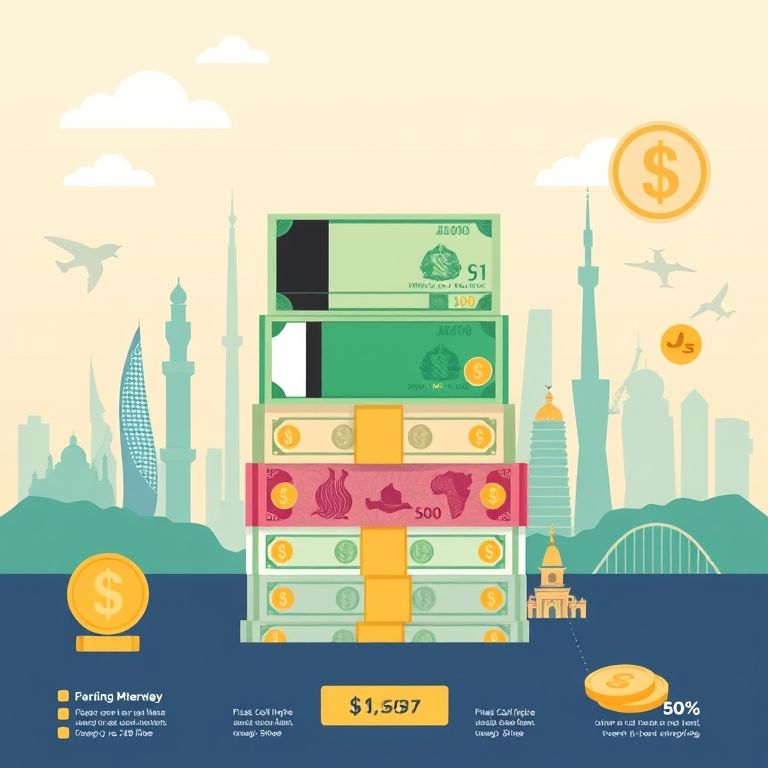Which country has the heaviest currency?
Which country has the heaviest currency?
Introduction
If you’ve ever flipped through foreign notes and wondered why some currencies look “heavier” than others, you’re not alone. The Kuwaiti dinar often gets pegged as the heaviest nominal unit, with other Gulf currencies following close behind. But in trading, weight is less about a price tag and more about carry, liquidity, and how that weight interacts with a diverse world of assets—from forex and stocks to crypto, indices, options, and commodities. This piece takes you through the reality on the ground, from prop trading desks to DeFi experiments, and what it means for your next trade.

What makes a currency “heavy”?
- Nominal value versus buying power: A currency can have a high face value yet behave like other currencies in the market. Heavy nominal value often comes from pegs or baskets that keep the unit strong against the USD, not from inflation alone.
- Economic underpinnings: Oil wealth, fixed or managed pegs, and fiscal surpluses push heavier notes into circulation, but they also tame volatility if policy is predictable.
- Liquidity and convertibility: Even a heavy currency loses edge if the market for it is thin or expensive to move in and out of.
Top contenders today
- Kuwaiti dinar (KWD): Known for a high nominal value, roughly around 3+ USD per dinar in recent years. The scale is impressive, but activity is concentrated and policy-driven.
- Bahraini dinar (BHD) and Omani rial (OMR): Values around 2.5–2.7 USD per unit, with pegs or managed regimes that emphasize stability.
- The takeaway for traders: “Heavy” often means a three-way balance—policy predictability, oil-linked economics, and limited but steady liquidity. Don’t chase headline price tags alone; assess liquidity, spreads, and trading hours.
Implications for prop trading
- Carry and hedging opportunities: These currencies can offer compelling carry when paired with structurally different rate environments. But carries carry risk—policy shifts can squeeze those trades fast.
- Liquidity as a constraint: Heavy currencies don’t always trade as liquidly as USD pairs, which affects slippage and execution quality across asset classes.
- Cross-asset correlations: In a multi-asset desk, a move in a heavy currency can ripple into oil, regional stocks, and regional bond markets. That creates hedging opportunities but also cross-asset risk to monitor.
Multi-asset trading advantages and cautions
- Diversification across forex, stocks, crypto, indices, options, and commodities helps you test carry ideas with a broader risk lens.
- Use strong risk controls: position sizing, stop losses, and stress tests that include pegged currency shocks, commodity price moves, and rate surprises.
- Example mindset: If you’re eyeing energy equities or oil proxies, a heavy currency backdrop can amplify or dampen USD denominated moves—plan for both directions.
DeFi, AI, and the evolving landscape
- Decentralized finance is expanding beyond a single chain toward cross-chain liquidity and automated market makers. It offers new ways to access liquidity and diversify exposure, but security, liquidity fragmentation, and regulatory clarity remain challenges.
- AI-driven trading and smart contracts are accelerating, letting desks simulate macro scenarios, optimize risk budgets, and execute disciplined strategies at machine speed. The risk is model drift and overfitting—keep guardrails and real-world checks.
- For a trader, DeFi plus traditional prop trading means learning new force multipliers: programmable risk controls, automated rebalancing, and transparent performance logging.
Strategies and reliable practices
- Map currency weight to your asset mix: heavier currencies can hedge macro risk but may move differently than equities or crypto in risk-off episodes. Build cross-asset hedges accordingly.
- Start with backtests and paper trades: test carry ideas against rate trajectories and oil cycles before committing real capital.
- Keep it simple at first: keep core strategies focused on liquidity, costs, and clear risk limits. Layer in AI insights and DeFi tools as you gain experience.
- Slogan to remember: Heavy currency, sharper trades. Hold value, move with confidence. This isn’t just about price tags—it’s about how weight translates into risk and opportunity.
Future outlook
- Prop trading will likely lean more on cross-asset desks with smart contract-enabled workflows and AI-assisted decision making. The rise of DeFi tools brings efficiency, but the real test remains security, regulation, and reliability.
- The heavy currencies foothold may persist, but their value as a tradable signal depends on how risk, liquidity, and macro policy interact in a volatile, interconnected market.
In the end, which country has the heaviest currency? The conversation isn’t only about which note weighs most, but how its weight affects your portfolio, your risk lens, and your ability to seize opportunities across a fast-moving, multi-asset world. Heavy value invites smarter trades.
YOU MAY ALSO LIKE